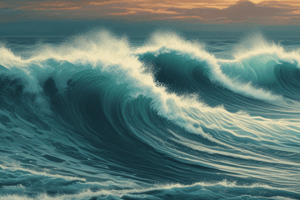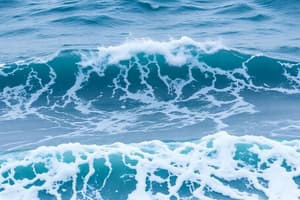Podcast
Questions and Answers
What two types of waves can impact the profile of a beach and how do they differ from each other?
What two types of waves can impact the profile of a beach and how do they differ from each other?
Constructive waves build up the beach as they deposit material, having a stronger swash and weaker backwash, whereas destructive waves remove the beach by eroding material, having a weaker swash and stronger backwash.
What factors affect the size of a wave?
What factors affect the size of a wave?
The strength of the wind, the amount of time the wind blows, and the length of the fetch.
What is the difference between a bay and a headland, and how are they formed?
What is the difference between a bay and a headland, and how are they formed?
A bay is a curved inlet of soft rock that erodes easily, whereas a headland is a rugged point of hard rock that erodes slowly, formed by the erosional action of waves.
What is the relationship between joints, cracks, and faults in rocks and their susceptibility to erosion?
What is the relationship between joints, cracks, and faults in rocks and their susceptibility to erosion?
What are the four types of erosion mentioned in the text, and how do they differ from each other?
What are the four types of erosion mentioned in the text, and how do they differ from each other?
What is the process by which a headland is transformed into a stack, and what are the resulting landforms?
What is the process by which a headland is transformed into a stack, and what are the resulting landforms?
What is a wave-cut platform, and how is it formed?
What is a wave-cut platform, and how is it formed?
What is longshore drift, and how does it contribute to the formation of depositional landforms?
What is longshore drift, and how does it contribute to the formation of depositional landforms?
What is the difference between a spit and a bar?
What is the difference between a spit and a bar?
How do changes in wind direction affect the formation of depositional landforms?
How do changes in wind direction affect the formation of depositional landforms?
Flashcards are hidden until you start studying




